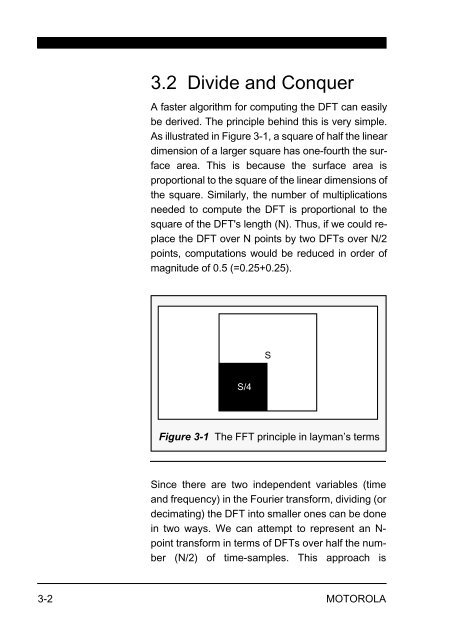Fast Fourier Transforms on Motorola's Digital Signal Processors
Fast Fourier Transforms on Motorola's Digital Signal Processors
Fast Fourier Transforms on Motorola's Digital Signal Processors
Create successful ePaper yourself
Turn your PDF publications into a flip-book with our unique Google optimized e-Paper software.
3.2 Divide and C<strong>on</strong>quer<br />
A faster algorithm for computing the DFT can easily<br />
be derived. The principle behind this is very simple.<br />
As illustrated in Figure 3-1, a square of half the linear<br />
dimensi<strong>on</strong> of a larger square has <strong>on</strong>e-fourth the surface<br />
area. This is because the surface area is<br />
proporti<strong>on</strong>al to the square of the linear dimensi<strong>on</strong>s of<br />
the square. Similarly, the number of multiplicati<strong>on</strong>s<br />
needed to compute the DFT is proporti<strong>on</strong>al to the<br />
square of the DFT's length (N). Thus, if we could replace<br />
the DFT over N points by two DFTs over N/2<br />
points, computati<strong>on</strong>s would be reduced in order of<br />
magnitude of 0.5 (=0.25+0.25).<br />
Since there are two independent variables (time<br />
and frequency) in the <str<strong>on</strong>g>Fourier</str<strong>on</strong>g> transform, dividing (or<br />
decimating) the DFT into smaller <strong>on</strong>es can be d<strong>on</strong>e<br />
in two ways. We can attempt to represent an Npoint<br />
transform in terms of DFTs over half the number<br />
(N/2) of time-samples. This approach is<br />
3-2 MOTOROLA<br />
S/4<br />
S<br />
Figure 3-1 The FFT principle in layman’s terms

















